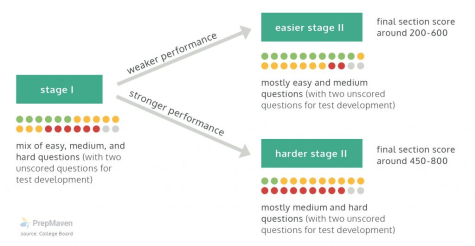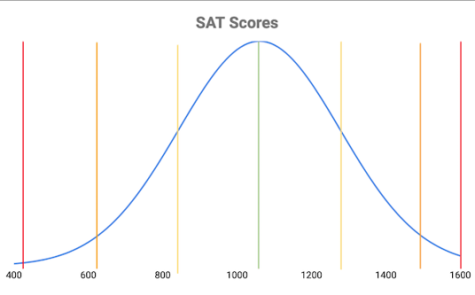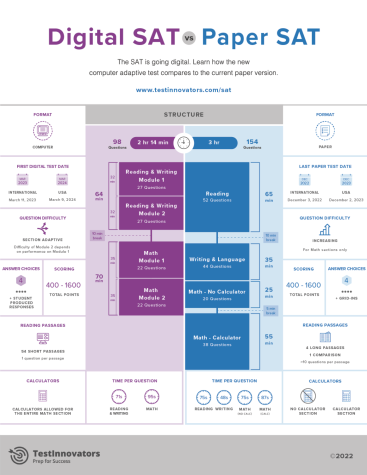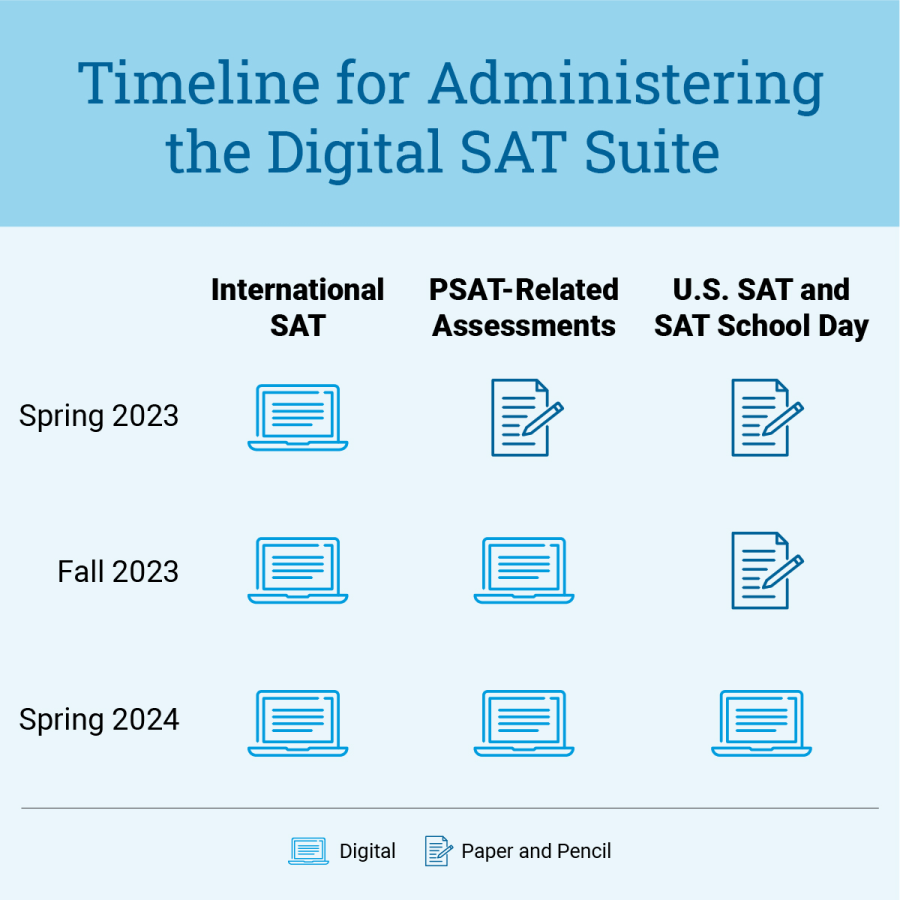I Took the Digital SAT, Here Are My Thoughts
April 11, 2023
The Scholastic Aptitude Test, better known as the SAT, is one of the defining parts of a student’s high school career. This paper and pencil test was made to standardize college admissions procedures and increase access to higher education. They grade a high schooler’s performance in a single sitting of the exam and give them a score ranging from 400 to 1600. This score is meant to project one’s ability to succeed in a college class. When high school seniors apply to college, universities can look at this single number and grasp a general idea of where that individual stands in the rest of the applicant pool.
While efficient for universities, many students dread this test, making it debatably one of the least cherished moments of high school. Additionally, College Board, the company that administers the SAT, charges sixty dollars for every test sitting—a financial burden on many families. Regardless of its aversive factors, nearly 2.2 million students in the class of 2020 took the SAT, earning the College Board millions of dollars in revenue. After the Covid-19 pandemic turned more than 80% of four-year colleges test-optional, however, the number of test-takers dropped to 1.5 million for the class of 2021. Even more recently, highly competitive colleges such as Columbia University have announced a permanent test-optional policy. Subsequently, many students no longer take the exam, seeing no benefit in spending hours studying for a grueling exam that they may not even submit. By losing hundreds of thousands of customers, the College Board has lost an estimated two hundred million dollars in revenue. Now, the company is fighting for its customers by opting for a more appealing and shorter digital exam.
What is this new test and what does it include? Allow me to walk through my experience with taking this exam. The entire process started last June after I received an email from the College Board notifying me that a digital SAT research study would take place in September. I simply signed up for the exam without thinking much of it, because the bottom of the email stated that “there [was] limited space in this study, and not all students [would] be selected to participate.” It was not until a whole month later that I received another email telling me I was one of the students selected and could fill out another registration to take an exam administered at Penn Wood Senior High School. The College Board was looking for students who were registered to take the August or October administration of the paper-and-pencil SAT, which I assume is because they wanted to compare students’ performances on the traditional SAT with the digital version. I agreed to register, enticed by the promise of either a fifty-dollar gift card or a refund of my August SAT fee if I took the exam. If you are curious, I chose the latter since I would get slightly more money back. Even though I registered again for the study, however, that still did not mean that I would take the exam. The College Board had to make a final selection. Somehow, I was picked to take the exam.
I got my first taste of the new format while taking the single practice test they gave me to prepare. I was told to download Bluebook, the test that you take the exam on. I used my usual laptop, but you can also use a school-issued device. Even when I took the actual test at Penn Wood, I used my laptop from home (adorned with my very own frog stickers). It was nine o’clock at night only three days before the day of my exam when I took the practice test. While taking this test so late might seem like a terrible idea, the digital exam is only two hours long instead of the current three-hour long paper-and-pencil version, so I finished around eleven.
The basic format includes two main sections: a reading and writing section, which is sixty-four minutes long, and a math section, which is seventy minutes long. These sections have two subsections called modules. I started with the first reading and writing module. Unlike the current SAT, reading and writing questions are mixed in the same section; however, there were clear distinctions between which ones were testing my reading comprehension and which were testing grammatical knowledge. I would get asked a few questions in a row about grammar and a few in a row about reading. The app includes a few tools such as a digital highlighter, notes to annotate on, and a timer at the top of your screen that tells you how much time is remaining. In my opinion, the highlighter and notes are pretty useless because they are extremely inefficient. You do not have the time to create a note, type in your annotations, and click your note to open and read it during the time slot. Unlike the two other tools, the timer was very helpful. Instead of bringing a watch to your testing place or relying on the clock hiding on the other side of the room, you can just look at the top of the computer screen.
The most significant change in the English section of the digital version is that there are no long passages. Instead, you read a short paragraph and answer one question about it. Thus, I was asked fifty-four questions and read fifty-four different paragraphs about fifty-four different topics. This proved to be quite mentally exhausting, as I had to switch topics every time I went to the next question, but on the other hand, there were no two-part questions. You no longer need to find evidence to support the answer to the previous question. I didn’t encounter one of those questions on the practice test or the real exam. Overall, I prefer this format because it is much easier to comprehend a paragraph than a page-long passage. On the current SAT, you have to dig for information and evidence from a long and dense passage. It is much easier to find answers in a four-sentence-long paragraph.
There are two new features of the reading and writing section: poetry and what I like to call “research questions.” I found the poetry confusing to comprehend because the language is quite complex, but it is by no means impossible. I was able to get these questions right with reasonable struggle. Contrarily, the research questions were my favorite. I was given a bullet-pointed list of notes that a student took while researching a topic. Using the information, I would have to choose effective information to craft an argument or find a counterargument. The biggest appeal was how refreshing it was to read short bullet points rather than a block of text.
After completing the first part, I started the second module. The digital exam is adaptive, so depending on my performance during the first module, I would get either a harder or an easier second module. Therefore, two people sitting next to each other may be taking different exams.
I found the second module much harder, hinting that I did well on the first part. The biggest change was the very apparent emphasis on random vocabulary words that no one ever uses. I remember parents telling me that this was the case on the old SAT, and it seems like the College Board is bringing it back. The test had me digging through mental cobwebs and contemplating latin roots to comprehend the meaning of words like engender, vindicate, and buttress, among many more. Overall, the module is difficult but manageable. If you take the digital SAT, all I can say is you desperately need to study vocabulary. Soon enough, I was done with the reading and writing section, and it was only around ten o’clock. I got a well-deserved break before I dove into the math section.
The math part was relatively similar to the current SAT, besides one big difference: you are allowed a calculator for the entire math section. You can use your own calculator, which I recommend, but the College Board also provides the desmos calculator app. In general, I found the questions in the math section to be exactly like the typical ones. There are still open-ended questions, but they are distributed throughout the entire module instead of at the very end. For example, the fifth question on my practice test was open-ended and my last one was multiple choice. This threw me off a little bit, but it was not a huge distraction. Unlike the reading and writing sections, there were no new types of questions that I found, so you could study efficiently with the current practice SAT material. There may have been a few more questions about graphs, such as transformations, but I generally saw little difference.
Once I got to the second math module, the College Board really wanted to see me struggle. In the English section, the difference between the two modules was light, but the math section was another story. Not only were the questions generally harder, but they were much more time-consuming. The section was completely doable but surprisingly difficult, especially considering that I don’t generally find the math section overbearing.

After I finally finished the exam around 11:30 pm, I was somewhat mentally drained — I mean, I just took the SAT — but I was much less exhausted than when I took the usual three-hour exam. After about two minutes, Bluebook spat out a score, and I was very surprised. I got way more points deducted for answering a single question wrong. Most shockingly, I only got four questions wrong in math, but they deducted ninety points. There are a few reasons for this. First, the scoring doesn’t just depend on the number of questions you get wrong, but also the types of questions you get wrong. Getting one question incorrect can result in you losing zero or maybe even thirty points. Someone else that got four questions wrong could have gotten a higher or lower score than I did just because they got different questions wrong. This point was verified by the College Board, but there are a couple of theories I have myself. Note that these are just speculation. For one, the digital exam has been widely regarded as easier than the paper-and-pencil version by many students. Because of this, people tend to perform better on it. Currently, the SAT is graded on a bell curve, so most people fall within a certain range of scores. To maintain this standard and gatekeep higher scores from high-achieving students, the College Board pushes these students down toward the average by deducting more points for making very few mistakes. This forces many kids to retake the exam and generates more profit for the testing company.

Another theory of mine is that you get more points deducted on the digital exam because there are simply fewer questions. The digital exam only has forty-four math questions compared to the current SAT’s fifty-eight math questions. As you are still scored out of eight-hundred points, each question has greater weight on your score.
Once the actual test day, September 17th, rolled around I felt very unprepared with only one test for practice. Nevertheless, I headed to the testing site with my computer and student ID. Once I got to Penn Wood, I suddenly realized that I had left my calculator at home. I panicked but remembered that I could just use the calculator on the test. While it was not ideal, it would suffice. I entered the testing room with about twenty other kids and the proctor gave a normal rundown. Soon enough, the proctor announced that we could begin our test, and we all started the first English module. The test was very similar to the practice test. All the questions were asked the same way, just about different topics. I proceeded to the second English module, and I recognized the steep increase in difficulty. Though I did not appreciate the rigor of the questions, I was content knowing I did well on the first module. I had about three minutes left on my timer when some of the other kids started to leave the room. Though confused, I ignored the distraction, too focused on answering the questions correctly. After I finished the English section, I got up and took a stroll down the hallway, and I finally realized why people were leaving during the test. Because everyone clicks when to start the timer on their own computer, everyone finishes at different times. While I was strolling down the hallway, some kids were still trying to comprehend a poem, and some could have even started their math module. In fact, there is a button that you can click to take a break in the middle of a module. I think this is pretty useless, though, because your time still runs down while taking this pseudo-break.
The intermission shortly ended, and I began the first math module, dreading the digital calculator. The first math module was no different from the previous one. I was asked the same questions as before, as far as I remember, but it was a pain to type equations into the calculator. However, I had plenty of time on this section even though I had to spend extra minutes handling the unwieldy calculator. When I got to the second math module, the College Board decided to kick it up ten notches. Some of the questions I got took so long to solve and required very advanced and specific knowledge. At least I knew I did well on the first math module. I had a false sense of security with so much time in the first module, and I lost track of time trying to solve some of the hardest questions. I eventually had to rush at the end and, before I could even check any of my answers, the timer ran out and I was kicked out of the test. After I left the testing location, I quickly forgot about the exam, the release of my score coming out a whole four months later on January 20th.
After waiting for so long, I finally received my score. I was given a five-day period to decide whether I wanted to make the score official. Because this was a study and I volunteered to take it, I could decide if I wanted to keep it or never let it see the light of day. I decided to keep it. Once it became official and went onto my College Board account, though, I was unable to see the test questions or my answers
On the current SAT, you can pay for the “Question and Answer Service,” which shows all the questions, answers, explanations, difficulty, and subject matter of every question on the exam you took. When I searched for this service, I couldn’t even see how many questions I got wrong like on the unofficial practice test. I figured that this was just because my exam was part of the study, and they might want to keep the questions confidential; however, this does not seem to be the case. Just a few weeks ago, international students took the first ever digital SAT during the March administration. The College Board has also not provided those international students with any information about the tests they took.
Only time will tell how the rest of the world reacts as the new digital SAT rolls out internationally and domestically. This past March administration was the first time this digital test has ever been taken by people outside of the College Board’s studies. In the United States, kids will not see the digital SAT until a whole year from now in March of 2024, but they will encounter the first-ever digital PSAT, or Preliminary SAT, this fall. How this change will affect the National Merit Scholarship qualification is unclear, but it may also have no effect on it at all. Already there has been some backlash for this exam, with some claiming that it is no longer a standardized test because people receive different questions, but it has also received praise for being less draining for the test-taker. Public opinion about the digital SAT seems mixed yet stagnant since most people have not actually taken the exam.

Reflecting on my overall experience with the test, I can’t wait for this new exam to be released to the world. While the classic paper-and-pencil exam does hold some benefits such as easier capacity to annotate reading passages, it drags behind the digital SAT. The short passages, freedom to use a calculator, and above all, the shortened length of the test create a far less overwhelming experience. I genuinely found this new version to be easier, especially because the reading section has always been my achilles heel, and the changes generally affected that section more than math. Still, this test remains the monster it alway has been. In the end, I will always despise the SAT, whether with a pencil or a laptop, but I know that if I were to rewind time and change all of my paper-and-pencil tests to the digital ones, I would detest the process a little less.







